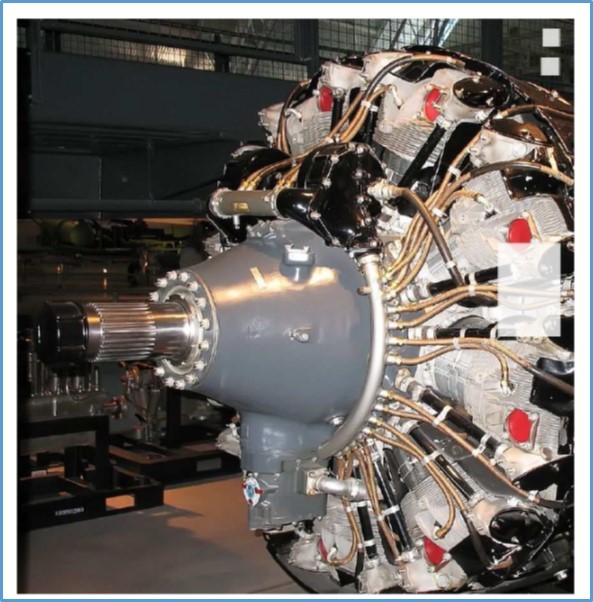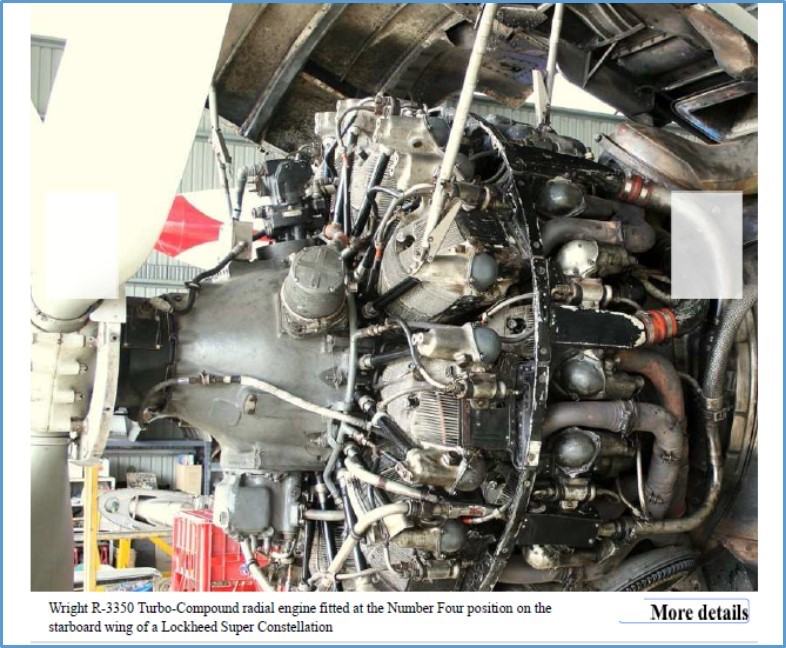In 1937, the Curtis-Wright R-3350 radial engine had its first test run. This engine was the largest double-row, air-cooled radial engine of its time. Later versions produced over 3,000 hp.
The military used the R-3350 in World War II. It powered the B-29 Super Fortress and early Lockheed Constellation models.
But, the engine had many issues. One major problem was its tendency to catch fire. This happened because it destroyed exhaust valves due to poor cooling design. The exhaust manifold for the front row of cylinders points forward. This design sends heat back into both rows of cylinders. See figure 1.

Figure 1 – static display of early R-3350 with exhaust ports (red) facing forward.
I’ve often wondered why they made this design choice. It may have been a financial decision to cut manufacturing costs. Forward-facing exhaust stacks are easier to form. They need no twists or turns. A short, straight section leads into the collector ring. This ring is in front of both rows of cylinders. In the earlier Curtis-Wright R-2600 engine design, the exhaust ports faced rearward. Anyone who has seen these engines at night remembers blue flames from the exhaust stacks. Temperatures hit around 2,600°F. This heat near air-cooled cylinders leads to cooling issues.
Was this design forced on the engineers? No one would allow such a design to go into mass production, yet it did. This flaw led to many B-29 crashes. One of the worst incidents was the tragic accident that took test pilot Eddie Allen’s life during prototype testing. The aircraft lost its crew and several people in a Seattle office building it hit.
Crash Coverage Link:
http://www.historylink.org/index.cfm?DisplayPage=output.cfm&file_id=2874
Igniting magnesium alloy components worsens engine fires. As a result, it can cause major failures.
During early bombing raids over Japan, B-29 reliability was very poor. Curtis LeMay’s aggressive engine maintenance and replacement procedures aimed to cut aircraft losses. They changed the engines after about 25 hours of use, which is over two missions, if my sources are right.
Postwar Lockheed Constellation engines had exhaust ports in the front row that faced backward. See figure 2. The only airworthy B-29 today, Fifi, had an engine change years ago. This change included these post-war engines. A crew member observed that a new engine started “making metal” in under seven hours of runtime before it changed the wartime engines! Not possible to remove the adverb.
The engine had several challenges. One was the cast cylinder heads, which were not as strong as forged heads. Engineers used forged heads in the Pratt & Whitney R-2800 engine. This engine powered many WWII aircraft.

Figure 2-Lockheed Constellation R-3350 engine installation showing rear-facing exhaust manifold for front cylinders.
Engine Run Video:
https://www.youtube.com/watch?v=8Dp9zBL2Ttk
The Point of All This
Examine the design you plan to manufacture with a critical eye. Make tough decisions early to implement changes before mass production. History shows the dangers of not following this practice.
Modern design work can use tools that manufacturers lacked 70 years ago. Advanced software can simulate conditions, reducing the number of design iterations needed. While real tests are essential, we can get much closer to a working design now than in the past.
Analysis Approach
Since double-row radial air-cooled engines are reliable, an incremental analysis approach could work.
The Curtis-Wright R-2600 engine was the predecessor to the R-3350. Test data from the R-2600 can help fine-tune a simulation of the earlier design’s changes. These changes include forward-facing exhaust ports.
The first step would be to set up a simulation to replicate the current successful design. Then, the team would make changes to the 3-D model to add the forward-facing exhaust stacks and manifold.
Simulation Methods
CFD-Classical Linear Analysis
One simple simulation method would combine FEA and manual calculations. Heat conduction, convection, and radiation affect different surfaces. Steady-state heat sources from combustion and friction also play a role. Together, these factors create a thermal analysis. This gives a strong initial analysis. It also benefits from being a linear-type simulation.
Non-Linear CFD Approach
Next, you could use a CFD simulation with software like ANSYS CFX. Test data would be crucial for success. We will compare the simulation results to actual test data. We will adjust input variables to ensure a close match.
This method would be more costly than the linear approach, but given the high stakes, it would be worth it.
Engine Test
Finally, rebuilding an R-2600 engine with the forward-facing exhaust manifold may be necessary. This is vital considering the risk of fire—one of the worst failure modes in aircraft.
You could complete all these steps before committing resources to a new design. The team completed a thorough review. Now, they can move forward with the new design since they fixed a big issue.
Norman T. Neher, P.E.
Analytical Engineering Services, Inc.
Elko New Market, MN
www.aesmn.org